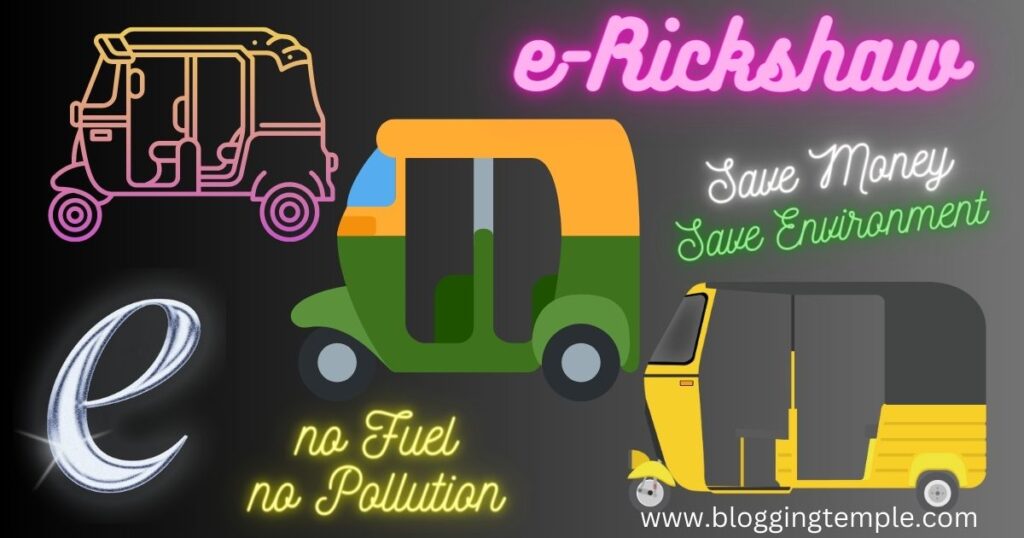Introduction
We will examine the main benefits and traits of commercial e-rickshaws in this post, illuminating why they have developed into a popular form of transportation for both drivers and passengers.
The demand for effective and sustainable transportation solutions is always growing in today’s fast-paced society. The commercial electric-Rickshaw is one such alternative that has grown significantly in favor in recent years. These electric-powered cars have a number of advantages, from affordability and environmental friendliness to adaptability and greater earning potential.
Table of Contents
Know About Electric Cars: https://bloggingtemple.com/the-top-10-electric-cars-in-the-market

Definition of Commercial e-Rickshaw
Commercial e-Rickshaws, often referred to as electric rickshaws or e-Carts, are battery-powered automobiles used to transport people or goods. They typically have three wheels and offer a greener option to conventional petrol or diesel-powered vehicles.
Growing Acceptance and Popularity
Commercial e-Rickshaw use has been extremely popular over the past ten years, especially in emerging nations and heavily populated urban areas. They have become a popular option for transportation due to their efficiency and sustainability in navigating through crowded cities.
Cost-effective and Environmentally Friendly
Low operating costs
Low operating expenses are one of the most important benefits of commercial e-rickshaws. Electric Rickshaws need a lot less energy to operate than conventional petrol or diesel vehicles. The cost of refueling with fossil fuels is significantly more expensive than recharging the electric batteries, therefore the drivers can save a lot of money this way.
Zero emissions
Commercial e-Rickshaws are renowned for being environmentally friendly. They have zero tailpipe emissions, which contribute to cleaner air and a less carbon footprint overall. Cities can significantly advance in meeting their environmental goals by converting from traditional fuel-powered rickshaws to electric ones.
Reduced dependence on fossil fuels
The decreased reliance on fossil fuels is another benefit of e-Rickshaws. Electric-Rickshaws offer a dependable and sustainable alternative to fuels with diminishing fossil fuel reserves and unpredictable fuel prices. Communities may reduce their reliance on foreign oil and work towards energy independence by adopting electric mobility.
Flexibility and Versatility
Suitable for various transportation needs
Commercial e-Rickshaws can be used for a variety of transportation applications because they are so adaptable. Electric Rickshaws are capable of carrying passengers over short distances, moving goods inside a city, and providing last-mile connection. They are the perfect vehicle for maneuvering through crowded spaces and tight streets thanks to their small size and flexibility.
Ability to navigate through congested areas
Traffic congestion is a significant issue in places with a high population density. E-Rickshaws provide a solution to this issue by gliding through crowded spaces with ease. Because of their small size, they may take detours, which saves time for both the drivers and the passengers. Due of this benefit, electric Rickshaws are a desirable option for local and short-distance travel.
Customizable features and configurations
Commercial e-Rickshaws have the extra benefit of having features and setups that can be changed. The design of an electric-Rickshaw can be altered to fit a variety of uses, depending on the particular needs. They are versatile in their use and can be equipped with covered cabins, extra seating, or cargo room.
Easy Maintenance and Accessibility
Simplified design and fewer mechanical parts
e-Rickshaws feature a more straightforward design than conventional cars and use fewer mechanical components. This simplicity translates to less expensive repairs and simpler maintenance. The likelihood of malfunctions and breakdowns is reduced with fewer components, which minimizes the drivers’ downtime.
Affordable spare parts and repairs
A further advantage of e-Rickshaws is the accessibility of reasonably priced maintenance and repairs. The supply chain for spare parts has grown more effective as the market for e-rickshaws expands. This accessibility guarantees that repairs may be made right away and without racking up significant costs.
Accessibility for drivers and passengers
The design of E-Rickshaws takes accessibility into account. They frequently have low floors that make it simple for passengers to board and exit. Electric rickshaws provide drivers with ergonomically designed controls and a comfortable driving position. Because of the focus on accessibility, electric rickshaws are a popular choice for both drivers and passengers and improve the overall user experience.
Increased Income and Job Opportunities
Entrepreneurship opportunities for drivers
Commercial e-Rickshaws have created new options for business, especially for those looking for self-employment. Aspiring business owners may find an electric-Rickshaw to be an appealing alternative due to the relatively inexpensive initial investment and decreased operational costs. Individuals can have more control over their income and work schedules by becoming electric-Rickshaw drivers.
Affordable mode of transportation for small businesses
E-Rickshaws provide a cost-effective means of transportation for small enterprises engaged in local transportation or last-mile logistics. Businesses may efficiently carry their goods throughout the city by using electric-Rickshaws rather than pricy delivery services or conventional automobiles. Small businesses may streamline their processes and contact clients more effectively thanks to this affordable option.
Boost to the local economy
The local economy is growing as a result of the extensive use of e-rickshaws. Jobs are created in the neighborhood as more drivers join the electric-Rickshaw industry. Furthermore, the lower operating expenses for drivers result in greater disposable income, which might boost nearby companies and services.
Safety and Comfort Features

Safety measures and regulations
In terms of transportation, safety comes first. To protect both drivers and passengers, commercial electric rickshaws must conform to a number of safety requirements. These safety precautions include equipment like seat belts, rearview mirrors, and headlights that make trips in electric rickshaws more secure.
Comfortable seating and spacious interiors
E-Rickshaws place a high priority on passenger comfort by providing plush seating and roomy cabins. Even on rocky roads, passengers can get a comfortable and smooth ride. Passengers may travel comfortably because of the ergonomic seating configuration, which guarantees enough head- and legroom.
Protection from weather conditions
Commercial e-Rickshaws are built to offer defense against a variety of weather situations. They frequently have weatherproof covers or cabin enclosures to protect occupants from the elements, including rain, sunlight, and high temperatures. The entire comfort and convenience of travelling in an electric rickshaw is improved by this function.
E-rickshaw Benefits
- Sustainable: Electricity, a renewable resource, powers e-rickshaws. Compared to conventional rickshaws or cars, they have no emissions, making them a more environmentally responsible choice.
- Affordability: Owning and operating an e-rickshaw is relatively inexpensive. They are therefore a desirable option for people and families with limited resources.
- Versatile: E-rickshaws can be employed for a range of tasks, including delivery, tourism, and transportation.
Problems with e-rickshaws
- Limited Availability: In many poor nations, electric rickshaws are still not generally accessible. Numerous issues, including hefty up-front expenses and a dearth of government backing, are to blame for this.
- Regulation: A lot of countries have not yet regulated e-rickshaws. Safety issues and unfair competition with other forms of transportation may result from this.
- Safety: If electric rickshaws are not adequately regulated and their drivers are not properly trained, they could be dangerous.
Incentives and Assistance by Governmental
Encouragement for e-Rickshaw adoption
Governments from all around the world support the use of electric Rickshaws and are aware of its advantages. They encourage the adoption of electric rickshaws by giving producers and drivers incentives, subsidies, and tax breaks. These actions are intended to cut carbon emissions and hasten the transition to sustainable transportation.
Financial subsidies and benefits
Governments provide financial incentives and benefits to encourage the use of e-Rickshaws. The initial cost of buying an electric-Rickshaw can be greatly reduced by these subsidies, making it a more practical choice for drivers. Governments may also offer incentives for the construction of charging infrastructure, providing easy access to charging stations.
Regulatory policies and guidelines
Governments also set up regulatory laws and standards to control how e-rickshaws operate. These rules guarantee adherence to criteria for driver licencing, car registration, and safety standards. The goal of governments is to strike a balance between promoting the use of electric rickshaws and protecting public safety.
Conclusion
Commercial e-Rickshaws have changed the game in the transportation industry by providing a variety of advantages and features. Electric rickshaws have completely changed urban transportation thanks to their affordability, environmental friendliness, adaptability, and accessibility. In addition to creating job opportunities and raising drivers’ incomes, the rising use of electric battery rickshaws has helped to create a future that is greener and more sustainable. We may anticipate additional developments in this cutting-edge method of transportation as long as governments continue to encourage and support its use.
You Can also Visit to Know More: https://www.binaryeducation.in/
FAQs
1. Are e-Rickshaws legal in all countries?
Electric Rickshaws can be used legally in some countries but not in others. Before operating an e-Rickshaw, it is crucial to confirm the local laws and license requirements.
2. Can e-Rickshaws travel long distances?
E-rickshaws are typically made for short trips inside of cities. Due to the limitations of the batteries and the availability of charging infrastructure, they might not be appropriate for extended journeys.
3. How much does an e-Rickshaw cost?
The price of an e-Rickshaw is determined by a number of elements, including the model, brand, battery size, and optional extras. Electric rickshaws often range in price from reasonably priced to moderately expensive.
4. How often do e-Rickshaw batteries need to be charged?
The capacity, mileage, and payload of an e-Rickshaw’s batteries all affect how frequently they need to be recharged. Electric rickshaw drivers typically recharge their batteries once every day or every several days.
5. What are the maintenance requirements for e-Rickshaws?
Compared to conventional vehicles, e-rickshaws require comparatively little maintenance. Regular servicing in accordance with the instructions of the manufacturer is advised, as well as periodic inspections of the battery, electrical parts, and mechanical parts.

